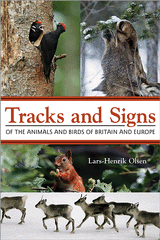 This book covers animals and birds (birds are animals!) of Britain and Europe (Britain is part of Europe!). It’s quite a good book.
This book covers animals and birds (birds are animals!) of Britain and Europe (Britain is part of Europe!). It’s quite a good book.
Because it covers the whole of Europe you will learn how to spot signs of Musk Ox or White Stork in your locality.
I don’t know much about identifying species from their scats, tracks in snow or mud, burrow entrances or discarded articles of food and so this is a book for people like me.
I’ve seen Otters a couple of times near my home. I’ve seen things that might be otter spraints but I’ve never been quite sure whether they were or weren’t. Does this book help me? It does, but not as much as I would expect. There are two photographs of otters and one photograph and one drawing of otter droppings in this book. I know what an otter looks like – and particularly if I saw one as well as in these two photographs then I can identify an otter for myself without this book. The text on otter scats is quite helpful but I would have thought, in a book on tracks and signs, that I might get a few more photographs of otter droppings to help me out. Yes, I know many would think it a strange thing to want, but that’s what I’d expect in a book of this title.
I turn to the hedgehog and get three photographs of hedgehogs (not the most difficult species to identify), one of a pile of brushwood, one (an excellent one) of footprints and another (quite useful) of scats.
I expected a section on how to tell which species had eaten an egg but I wasn’t given one. How do I tell the difference between Magpie and Carrion crow predation (if, indeed I can)? or between mustelid and Red Fox activity?
Overall, the book has a lot of attractive photographs of European mammals and some very useful maps of their distribution as well, but it seems to me to be a little light on tracks and signs.
Tracks and Signs of the animals and birds of Britain and Europe by Lars-Henrik Olsen is published by Princeton University Press and is available on Amazon, as is Mark Avery’s Fighting for Birds.
[registration_form]
In my experience, otter droppings (spraint) are quite variable in appearance depending on what the otter has been eating. However, they do have a very distinctive smell that has been likened to freshly mown hay and which is not entirely unpleasant. Did the book mention this? I use the sniff test regularly to distinguish otter spraint from mink scats.
I have also heard that pine marten scats smell of parma violets. However, I recently smelt a pine marten scat and could not detect this. I knew it was a pine marten scat as it was in front of a camera trap, which had photographed the marten depositing it!
Paul – thanks. New mown hay is not mentioned but fishiness is. Parma violets not mentioned.
“Britain is part of Europe!” – careful Mark!
My God! Is Ireland part of Europe too!
“Britain is part of Europe!”
Maybe geologically, but that 22 miles of salt water has quite an impact biologically. Think about robins, for instance; they’re effectively unafraid of humans in the UK, but incredibly shy on mainland Europe.
Another book by a similar title authored by Gerard Gorman is due out shortly I believe. It will be interesting to see how both books compare.